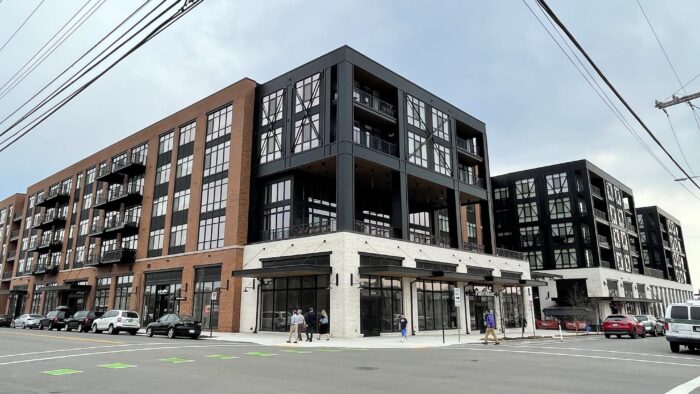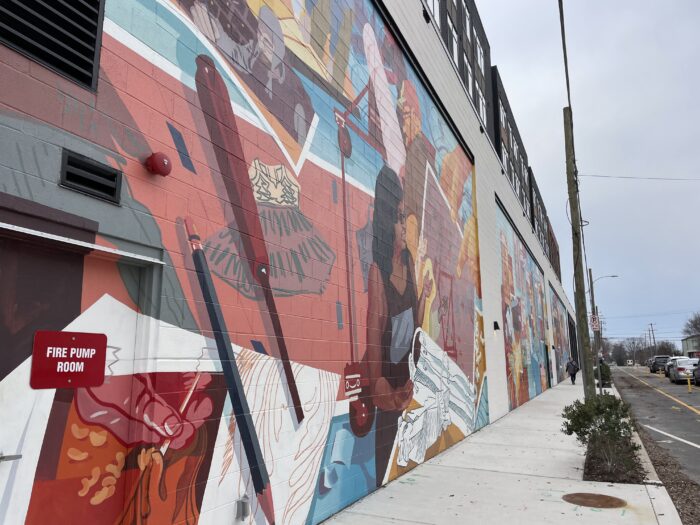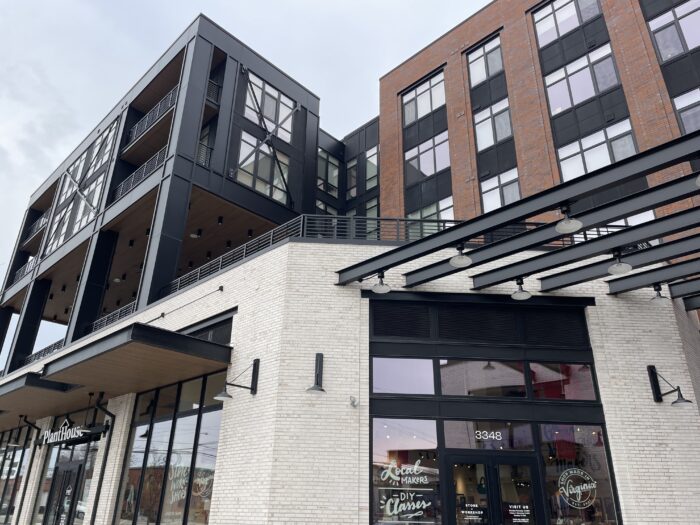It’s hard to argue with the observation by the august Washington, D.C.-based National Trust for Historic Preservation that “ground zero for Richmond’s recent renaissance isn’t downtown, but Scott’s Addition.”
But while apartment buildings continue to materialize at a dizzying clip in that neighborhood, adequate sidewalks, public parking, green spaces and distinctive new architecture are in short supply. There are, however, a handful of eye-popping architectural landmarks.
Consider the Hofheimer Building, an Arabian “One Thousand and One Nights” confection at 2818 W. Broad St. that was built in 1928. Or the Bauhaus-inspired HandCraft Cleaners structure at 1501 Roseneath Road, built in 1940 for Binswanger Glass Co. And if you squint at the 3600 West Broad apartment complex designed in the Moderne mode for the Seaboard Railroad in 1958, you might visualize a caboose. Finally, there’s the Yellow Umbrella Provisions retail and eatery settling into its rugged, cobblestoned-walled complex at 3101 W. Clay St. (formerly the Blue Bee cidery) that exudes unexpected charm.
So it’s a big deal to welcome the arrival of The Otis, a 21st-century landmark to Scott’s Addition.
This recently completed six-story behemoth has settled confidently into the entire city block defined by Roseneath Road, Norfolk Street, Mactavish Avenue and West Moore Street. It is situated directly across Moore from the HandCraft building that contains a Stella’s Grocery.
The massive, multiuse Otis structure was built out to its respective property lines and “claims” its space like few other buildings in the vicinity. Since Scott’s Addition contains a crazy quilt of structures – large and small, high and low, new or not-so new that occupy jaggedly unresolved open spaces with adjacent surface parking lots – The Otis delivers a much-needed anchor that boldly defines the tight and existing street grid. This 483,000-square-foot super structure provides three huge and continuous urban street walls (along Roseneath, Norfolk and Mactavish) plus a well-articulated fourth outer facade on the Moore Street side that’s punctuated with setbacks and open loggias (“the better on which to sun or barbecue, my dear”) that form a solid counterbalance to the Addition’s block after block of ill-defined cityscape.
Kudos to developers Greystar and Capital Square and architect Hord Coplan Macht (which has offices in Maryland; Washington, D.C.; North Carolina; South Carolina; and Colorado). They have handsomely packed quite a bit of activity into this square block; there are 350 apartments – studios, one-, two- and three-bedroom units and eight townhomes. There are 410 parking spaces on two levels (with access and egress from Norfolk Street). Retail occupies 16,000 square feet. Communal spaces include an outdoor swimming pool and terraces and loggias designed to draw the community together while offering excellent vistas of the former industrial district.
Although all four sides of the Otis face out to the city, the Moore Street facade best shows the mixed-use aspects of the structure. The building facade on the upper levels is broken into three pavilions that project to the sidewalk with recessed red brick walls, which define living space. The ground floor here is a two-story plinth faced in white bricks that complements the white walls of the HandCraft building. A Plant House store and a Cochiloco Mexican restaurant that open onto Moore Street animate the sidewalk, and a cafe, the Grit Coffee Roasting Co., opens onto Roseneath Road around the corner.
The upper floors fronting Moore Street are defined by a clearly delineated skeletal grid of thick steel girders, colored flat black, that support generous-sized glass window openings. The effect is unforgivingly but pleasingly muscular and delivers on what The Otis marketers promote as “industrial modern.”
The main pedestrian entrance to the residences is from Roseneath Road. The building here is faced in warm red brick, tying in with the ubiquitous and vintage building material in the district. The Norfolk Street parking garage is entered through large bays. The contrast in scale between the parking facility and drivers or pedestrians is mitigated by a long, two-story high mural that was commissioned for the exterior wall. This colorful and brightly hued figurative ode to the urban scene was painted by Richmond artist Emily Herr of the HerrSuite firm.
Since many new buildings in Scott’s Addition, as in Manchester, Shockoe Bottom and downtown, are tepid architecturally, The Otis, while nothing if not confident, arrives full blown as a good and welcome neighbor. An unforgiving wall was given a mural, proportionate in scale to the building. In contrast, the West Moore Street facade is also a pleasure to gaze upon – with heavy metal that gives way to openings, setbacks and glass walls that respect surrounding buildings and engage visitors and neighborhood folks moving through them.
It is clear that The Otis intends to be in and of a city, not a backwater.
It’s hard to argue with the observation by the august Washington, D.C.-based National Trust for Historic Preservation that “ground zero for Richmond’s recent renaissance isn’t downtown, but Scott’s Addition.”
But while apartment buildings continue to materialize at a dizzying clip in that neighborhood, adequate sidewalks, public parking, green spaces and distinctive new architecture are in short supply. There are, however, a handful of eye-popping architectural landmarks.
Consider the Hofheimer Building, an Arabian “One Thousand and One Nights” confection at 2818 W. Broad St. that was built in 1928. Or the Bauhaus-inspired HandCraft Cleaners structure at 1501 Roseneath Road, built in 1940 for Binswanger Glass Co. And if you squint at the 3600 West Broad apartment complex designed in the Moderne mode for the Seaboard Railroad in 1958, you might visualize a caboose. Finally, there’s the Yellow Umbrella Provisions retail and eatery settling into its rugged, cobblestoned-walled complex at 3101 W. Clay St. (formerly the Blue Bee cidery) that exudes unexpected charm.
So it’s a big deal to welcome the arrival of The Otis, a 21st-century landmark to Scott’s Addition.
This recently completed six-story behemoth has settled confidently into the entire city block defined by Roseneath Road, Norfolk Street, Mactavish Avenue and West Moore Street. It is situated directly across Moore from the HandCraft building that contains a Stella’s Grocery.
The massive, multiuse Otis structure was built out to its respective property lines and “claims” its space like few other buildings in the vicinity. Since Scott’s Addition contains a crazy quilt of structures – large and small, high and low, new or not-so new that occupy jaggedly unresolved open spaces with adjacent surface parking lots – The Otis delivers a much-needed anchor that boldly defines the tight and existing street grid. This 483,000-square-foot super structure provides three huge and continuous urban street walls (along Roseneath, Norfolk and Mactavish) plus a well-articulated fourth outer facade on the Moore Street side that’s punctuated with setbacks and open loggias (“the better on which to sun or barbecue, my dear”) that form a solid counterbalance to the Addition’s block after block of ill-defined cityscape.
Kudos to developers Greystar and Capital Square and architect Hord Coplan Macht (which has offices in Maryland; Washington, D.C.; North Carolina; South Carolina; and Colorado). They have handsomely packed quite a bit of activity into this square block; there are 350 apartments – studios, one-, two- and three-bedroom units and eight townhomes. There are 410 parking spaces on two levels (with access and egress from Norfolk Street). Retail occupies 16,000 square feet. Communal spaces include an outdoor swimming pool and terraces and loggias designed to draw the community together while offering excellent vistas of the former industrial district.
Although all four sides of the Otis face out to the city, the Moore Street facade best shows the mixed-use aspects of the structure. The building facade on the upper levels is broken into three pavilions that project to the sidewalk with recessed red brick walls, which define living space. The ground floor here is a two-story plinth faced in white bricks that complements the white walls of the HandCraft building. A Plant House store and a Cochiloco Mexican restaurant that open onto Moore Street animate the sidewalk, and a cafe, the Grit Coffee Roasting Co., opens onto Roseneath Road around the corner.
The upper floors fronting Moore Street are defined by a clearly delineated skeletal grid of thick steel girders, colored flat black, that support generous-sized glass window openings. The effect is unforgivingly but pleasingly muscular and delivers on what The Otis marketers promote as “industrial modern.”
The main pedestrian entrance to the residences is from Roseneath Road. The building here is faced in warm red brick, tying in with the ubiquitous and vintage building material in the district. The Norfolk Street parking garage is entered through large bays. The contrast in scale between the parking facility and drivers or pedestrians is mitigated by a long, two-story high mural that was commissioned for the exterior wall. This colorful and brightly hued figurative ode to the urban scene was painted by Richmond artist Emily Herr of the HerrSuite firm.
Since many new buildings in Scott’s Addition, as in Manchester, Shockoe Bottom and downtown, are tepid architecturally, The Otis, while nothing if not confident, arrives full blown as a good and welcome neighbor. An unforgiving wall was given a mural, proportionate in scale to the building. In contrast, the West Moore Street facade is also a pleasure to gaze upon – with heavy metal that gives way to openings, setbacks and glass walls that respect surrounding buildings and engage visitors and neighborhood folks moving through them.
It is clear that The Otis intends to be in and of a city, not a backwater.






Otis is definitely the best new architecture in Scott’s addition
This may actually be true, but it is not saying much. Like a 2nd grader bragging she is taller than all the kindergartners.
Genius retort, good sir. Huzzah!
Capital Square comes correct on bringing projects that are far more than just boxes to store people in. Can’t wait to see what they do with the old Dairy Bar site.
To look at this non-descript box which is hardly different from every other new apartment building being thrown up around every part of the city & every city in the U.S., and claim it to be an “architectural landmark” (in the same city that has the Capitol, Old City Hall, The Jefferson, the Mosque, the Carillon, Main Street Station, the Science Museum, the original VMFA, Monumental Church, and many more) is absolutely absurd in the fullest meaning of the word.
I take it that you didn’t see the caboose either?
What caboose did you see? The one at 3600 West Broad? Because that’s not the Otis. If you saw a caboose at the Otis, something has gone terribly wrong: either an olde-timey train has derailed in Scott’s Addition, or you have been hallucinating. You saw something that wasn’t there because you read something that wasn’t written.
Lol. I was being facetious. triggered much?
Okay…not just me thinking that.
Every era has its own “look,” to be sure, but I refuse to believe that this is the best that contemporary architects are capable of. Richmond deserves better. The Otis might be a piece of chicken in a neighborhood of saltine crackers, but it’s served boiled and without an iota of seasoning…
Robbie! With the obligatory hat tip to Seinfeld, “okay, that’s not bind.”
*bad*
Absurd is a world class choice of descriptor (as is “descriptor” I dare say), Mr. Rowell. Different, yes. But in the sense that “they’re all different, but they’re all the same.”
I wonder what Richmonders would say is the best new construction of the last decade.
Excellent question! Would bet the new General Assembly Building is on the short list.
Probably the bus shelters in the middle of Broad Street. Extra points for creating the red slalom autocross course.
There’s a lot of capital flowing into Richmond as many developers have found that the Sun Belt cities are way over exposed and priced. Most agree that The Otis is the regions best mixed use development. Ed is correct with his praise regardless of the opinions expressed here by the amateurs. I’ve now lived in the City for 30 years and still amazed by the tireless criticism of every change.
All it takes is two eyes and at least half a shred of integrity to acknowledge that there is nothing amazing or unqiue about this building that makes it worthy of being called an “architectural landmark.” It is as non-unique as any 5-over-1 going up all around America right now. To pretend otherwise is disingenuous, and anybody with 2 eyes can see it. You can disparage the “amateurs” all you want, Mr. Milam, but they are the ones who have to work in it, live in it, look at it everyday, and interact with it. While the “pros” may design… Read more »
Common sense v. “Experts,” capital E.
Your response reminds me of Churchill’s schooling of H G Wells’s proposition that experts should rule.
Will post if I can find it. Credit to Hillsdale College I think.
S, happy amateur
Excerpt : Nothing would be more fatal than for the government of States to get into the hands of the experts. Expert knowledge is limited knowledge: and the unlimited ignorance of the plain man who knows only what hurts is a safer guide, than any vigorous direction of a specialised character. Why should you assume that all except doctors, engineers, etc. are drones or worse? Surely outside scientific spheres there are vast regions of human thought. Is not government itself, both an art and a science. To manage men, to explain difficult things to simple people, to reconcile opposite interests,… Read more »
I work in marketing and advertising and frequently hear, “But what are the best practices?” I counsel that if everyone only follows them and sets all guideposts to them, then we’ll only ever create average work. Breakthroughs take courage, risk taking, innovation, disruption to the norms. The overwhelming housing product of the times is managed to budget with nothing but best practices in mind.
Esp when it comes to taste.
I think the broader issue is that the “experts” have to have substantial expertise that has little to do with architectural design – they also have to be experts in code compliance, logistics/materials, zoning rules, architectural review processes, fair housing and disability law, financing and banking rules, and on and on… (if they want to get anything built, anyways…) …architecturally, this looks like a slightly more conservative version of the Atlantic Plumbing development in the Shaw neighborhood in DC. It’s fairly distinctive for Richmond specifically because it is new build with industrial aesthetics/detailing, rather than being a converted factory or… Read more »
While much smaller in scale, the new apartment building next door to the Hofheimer building looks pretty good.
Whilst no fan of this corporate architecture (I’ve seen ‘this’ in multiple new developments in multiple cities), what does better look like?
Can the detractors give examples of a better whole block, 300+ apartment and commercial development from the last 10 years? I’m genuinely interested in what better might be.
This seems to be “begging the question”. Why would you assume that there are better “whole block, 300+ apartment and commercial development from the last 10 years”? If there are no great examples out of the hundreds(?) of thousands of examples from the past decade, what might that mean about that development pattern, or our professions?
People here love to compare contemporary residential architecture to the best civic and commercial buildings in the city—it’s not a fair comparison. Not every building needs to be architecturally significant and The Otis looks great. I’m not understanding what there is to dislike because it looks high quality and it fits in well with its industrial neighborhood.
If we want to complain about an apartment building maybe talk about the new one at Monument and Hamilton or the not so new apartment at Cary/Belvidere—both have vinyl siding.
Nothing says well managed and caring city quite like vinyl siding.
Yes, not every building needs to be architecturally significant, and the Otis may blend in with its industrial neighborhood. But that is, by defintion, not an “architectural landmark,” which was the author’s base claim.
We don’t have to say the Otis is ugly or that it is plain and architecturally insignificant and blends in with other insignificant industrial buildings to recognize that it is not at all an “architectural landmark.”
I haven’t seen it in person, but knowing that area for over 50yrs. I certainly understand the excitement of seeing this new building come alive. What would it cost to build a Jefferson Hotel today?
About the same as an Otis if the regs were the same as then.